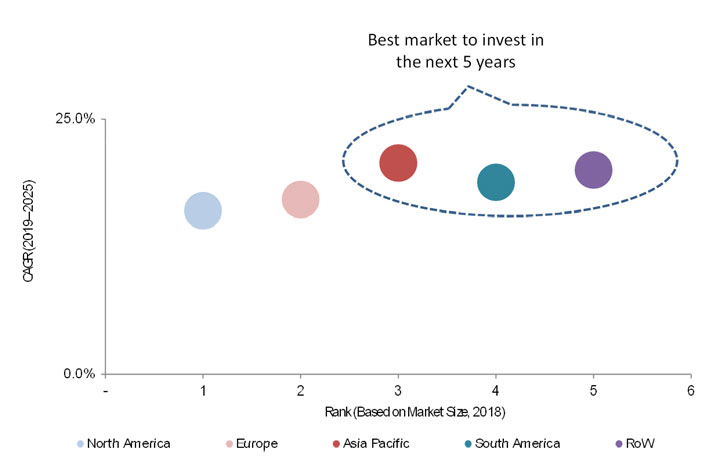The irrigation controllers market is driven by factors such as the growing need for water conservation, increased need for modern agricultural practices, the need for the adoption precision farming, and the growing lawn and garden area.
 Advancements in Remote Control Technologies in Irrigation Systems
Advancements in Remote Control Technologies in Irrigation Systems

Research from | MarketsandMarkets Research Pvt. Ltd.
Smart irrigation systems help in tailoring the watering schedules and run times automatically to meet the specific needs of the landscape, and that of crops as per their growth cycle. A component of a smart irrigation system is an irrigation controller, which assists the control and operations of an automatic sprinkler. Also, sensor technologies allow farmers to determine the real-time farm conditions, such as soil moisture level and evapotranspiration rate, which considerably enhances field productivity by minimizing the utilization of natural resources. These advanced technologies help fabricate irrigation controllers, which can be classified into weather-based and sensor-based, based on their working modules. The growing concern for water conservation has been a major driver for the irrigation controllers market in recent years. According to the United Nation’s statistics on water withdrawal, almost 62% of water withdrawal has been from the agricultural sector across the globe, wherein Asia was the largest contributor. A significant portion of this water is wasted through leaching. Hence, various institutions and organizations are participating in promotional and educational activities to support farmers or growers for sustainable environmental practices. For instance, the US government has been providing rebates on EPA WaterSense Certified weather-based controllers to increase technology-oriented irrigation in the country.
The irrigation controllers market is driven by factors such as the growing need for water conservation, increased need for modern agricultural practices, the need for the adoption precision farming, and the growing lawn and garden area. Moreover, continuous upgradation in communication technologies has been creating opportunities for the irrigation controllers market, as it helps growers or residential users to access their irrigation systems remotely. Additionally, the growing awareness about the advantages of mechanized irrigation among farmers is causing a rapid shift from flood irrigation toward mechanized systems in countries such as Australia and New Zealand. This shift is also expected to present opportunities to irrigation controller manufacturers to automate the entire irrigation system, which would result in efficient water supply and reduced cost of operations.
According to MarketsandMarkets analysis, the irrigation controllers market is projected to grow nearly at 17.5% in the coming years to reach a value of USD 1.6 billion by 2024. The extensive adoption of automated and mechanized irrigation systems, such as drip and sprinkler irrigation systems, across North American and European countries, has led to a higher demand for irrigation controllers. Moreover, advanced technologies have been increasingly explored by manufacturers to enable remote control. In January 2019, Rain Bird (US), one of the key players in the irrigation controllers market, developed Rain Bird controllers featuring the LNK WiFi Module, which would enable the farmers to control their irrigation systems through Google Assistant and Google's digital assistant using their voices or through just a few simple taps.
Growth Opportunities for the Irrigation Controllers Market During the Forecast Period

The market for irrigation controllers is observed to be consolidated. Some of the automated irrigation system manufacturers developing these controllers include Valmont Industries (US), Lindsay Corporation (US), Toro (US), Rain Bird (US), Hunter Industries (US), and Netafim (Israel). Based on the adoption of irrigation systems and company revenues, North America is the dominant market for irrigation controllers, with the US leading the market in the region. The advanced technological irrigation systems in these regions have been applied in cornfields. Also, favorable regulations have encouraged the adoption of smart irrigation systems in the region.
On the other hand, the adoption of smart agriculture techniques and the rising awareness about water conservation are expected to enhance the growth opportunities for irrigation controllers in Asia Pacific countries, reflecting a high growth potential for this market in the coming years.
Conclusion
The demand for advanced irrigation controllers is majorly driven by consumers in the developed countries, while it is industry-driven across developing economies. The countries significantly contributing to the growth of the Asia Pacific market include China, India, Japan, Australia, and New Zealand. The rapid growth of the golf industry and the increasing trend of greenhouse farming are also projected to fuel the growth of the irrigation controllers industry at a rate greater than 15% in the next five years.
The content & opinions in this article are the author’s and do not necessarily represent the views of AgriTechTomorrow
Comments (0)
This post does not have any comments. Be the first to leave a comment below.
Featured Product

